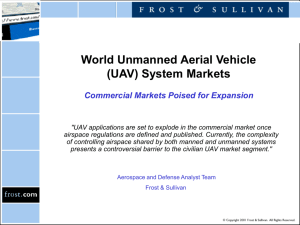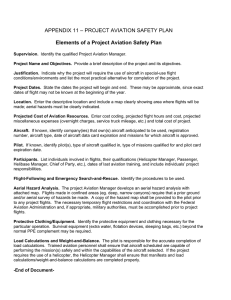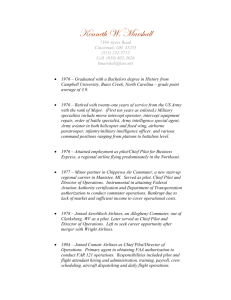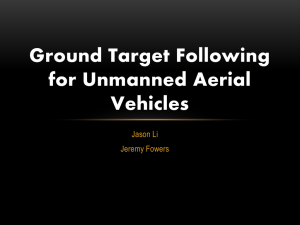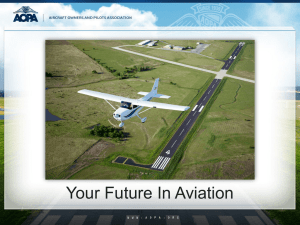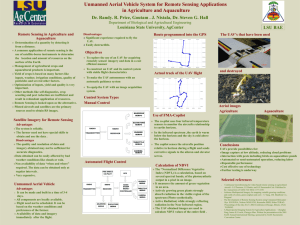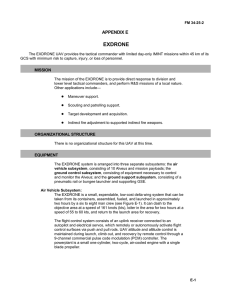INITIAL 0 / RENEWAL 0 / VARIATION 0
advertisement
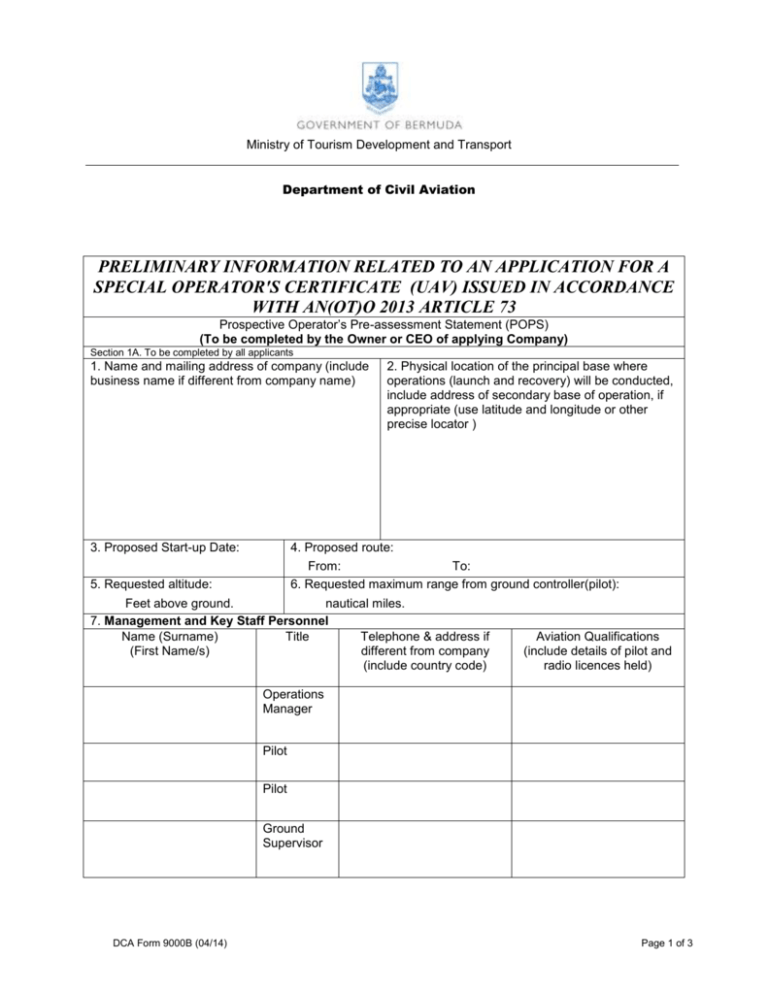
Ministry of Tourism Development and Transport Department of Civil Aviation PRELIMINARY INFORMATION RELATED TO AN APPLICATION FOR A SPECIAL OPERATOR'S CERTIFICATE (UAV) ISSUED IN ACCORDANCE WITH AN(OT)O 2013 ARTICLE 73 Prospective Operator’s Pre-assessment Statement (POPS) (To be completed by the Owner or CEO of applying Company) Section 1A. To be completed by all applicants 1. Name and mailing address of company (include business name if different from company name) 2. Physical location of the principal base where operations (launch and recovery) will be conducted, include address of secondary base of operation, if appropriate (use latitude and longitude or other precise locator ) 3. Proposed Start-up Date: 4. Proposed route: 5. Requested altitude: From: To: 6. Requested maximum range from ground controller(pilot): Feet above ground. nautical miles. 7. Management and Key Staff Personnel Name (Surname) Title Telephone & address if (First Name/s) different from company (include country code) Aviation Qualifications (include details of pilot and radio licences held) Operations Manager Pilot Pilot Ground Supervisor DCA Form 9000B (04/14) Page 1 of 3 8. Proposed type of operation (Check as many as applicable) Personal and Property surveillance. Photography. Law Enforcement Operations. Recreational Use. Other. Describe: 9. Details of Insurance (including third party liability cover) 10. Training details (provider, venue, course scope and duration): Initial Training: Recurrent Training: 11. The statement and information contained on this form denotes intent to apply for a Bermuda Department of Civil Aviation (BDCA) Special Operator’s Certificate (UAV). Signature Date (day/month/year) Name and Title Supporting Documentation: 1. 2. The following documentation in support of the above application is to be submitted to the DCA. A Risk Management Analysis: a. Identification of Risks, consideration should be given to degradation or loss of: i. Command and control links ii. Telemetry data links iii. Communication links with ATC and/or pilot iv. Sense and avoid links v. Propulsion system vi. Control station power vii. Software systems viii. Visual contact with aircraft when operating within visual range b. UAV encounters with: i. Another aircraft ii. Varying weather conditions iii. Aborted take-off or landing of the vehicle c. Assessment of implications d. Mitigation of risks Operations Manual or Procedures Handbook (to include procedures and processes in relation to the following items): a. Terms of reference and duties of Operations Manager and Ground Supervisor. b. Type and purpose of the operation. c. Methods of contacting Operations Manager, Ground Supervisor and pilots directly during flight operations. d. Complete description, including all pertinent flight data on the aircraft to be flown: i. Air Vehicle description. ii. Control Station description. DCA Form 9000B (04/14) Page 2 of 3 iii. Communication Links description: 1. Command and control 2. ATC communications 3. Sense and avoid iv. Payload e. Security plan for the area of operation (launch and recovery) and the area to be overflown to ensure no hazard is created to persons or property on the surface. f. Emergency contingency plan to deal with any disaster resulting from the operation. g. Detailed plan describing how the operation shall be carried out. The plan should include a clear legible presentation in the form of a scale drawing, aerial photograph or large scale topographical chart and must include the following information: i. Location and height above ground of all obstacles in the approach and departure path to the areas where the operation will be conducted. ii. The exact boundaries of the area where the actual operation is to be conducted. iii. The altitude and routes to be used when conducting the operation. h. Pilot requirements (to include): i. Demonstrated skill test ii. Knowledge: 1. Completed Ground training. 2. Basic aviation theory. Principles of flight, aerodynamics etc. 3. Knowledge of air traffic control rules and procedures, communications and radiotelephony. 4. Knowledge of aviation law (BDCA examination), meteorology, navigation, airmanship and flight planning. 5. Knowledge specific to UAV system. iii. Experience: 1. Experience on manned aircraft. 2. Experience on model aircraft. 3. Experience on specific UAV. 4. Experience on all UAVs. iv. Training: 1. System specific to include all critical emergencies (engine failure, electrical failure, engine over-heating, control station failure, smoke and fire in the control station). 2. UAV system manufacturer’s training. 3. Company/Organization operations training. 4. Crew Resource Management Training. 5. Other relevant training courses. v. Weather limitations. vi. General Operating and Flight Rules. vii. Environmental Considerations viii. Occurrence Reporting (as required by AN(OT)O 2013 Article 174). 3. Certificate of Insurance: a. Insurance cover should be a minimum of 1,000,000 SDRs (Special Drawing Rights) DCA Form 9000B (04/14) Page 3 of 3


